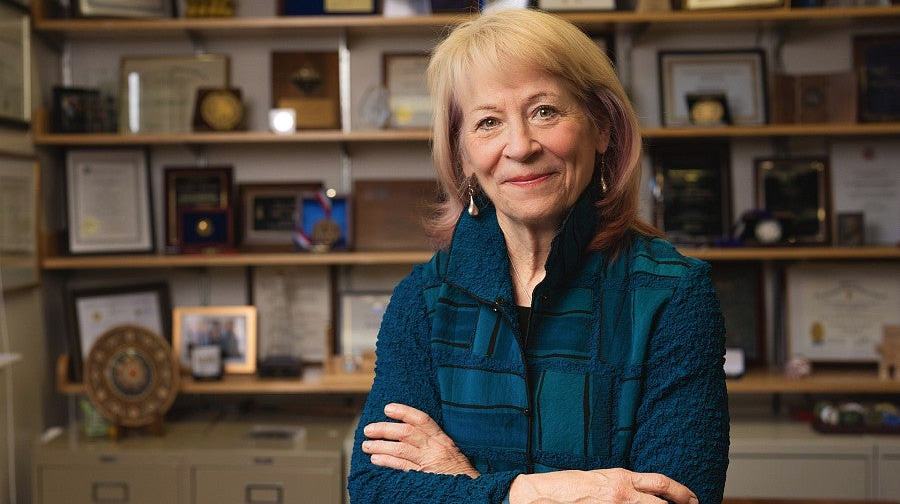
Story by Matt Cooper. Photo by Nicolas Walcott. Published April 9, 2025 in OregonNews. Geri Richmond is a CSWS faculty affiliate.
After serving four years as undersecretary for science and innovation at the U.S. Department of Energy, chemistry professor Geraldine “Geri” Richmond is back at the University of Oregon’s Eugene campus.
During her absence, Richmond was one of the top science officers in the federal government, overseeing billions of dollars in research spending on some of the nation’s highest science priorities, including quantum computing, clean energy and national security. She will pick up much where she left off, doing research, mentoring undergraduate science students and helping lead COACh, the Committee on the Advancement of Women Chemists, a group she co-founded to help female scientists.
In her own research, Richmond uses laser-based and computational methods to understand the structure and dynamics of liquid surfaces that are relevant to environmental and technological interests. She has taught and conducted research at the UO since 1985.
She recently sat down for an interview with OregonNews to discuss her past federal service as well as the future of government-funded research.
OregonNews: What was your role at the U.S. Department of Energy?
Geri Richmond: I oversaw 13 of the 17 DOE national laboratories, including Lawrence Berkeley National Laboratory, Argonne National Laboratory and the National Renewable Energy Laboratory. The laboratories conduct basic and applied research that addresses national priorities such as energy, the environment and national security. In addition to giving many talks around the country about the great science done by researchers that DOE funds at universities and the national laboratories, I also set the budget priorities for the $15 billion portfolio that funded the efforts. This included basic science research in DOE’s Office of Science in areas such as chemistry, physics, materials science and computational science, as well as the more applied research areas of nuclear energy, renewable energy technologies, the nation’s electric grid and carbon capture.
ON: During your tenure, you created the Critical Emerging Technologies Office. Why?
GR: Although my programs and the DOE laboratories had worked on research in artificial intelligence and quantum technologies for decades, it became clear that few people outside of our DOE laboratories knew about our world-leading research capabilities therein. The CET office was established to be the front door for anyone to learn about what DOE is doing in AI, quantum technology and biosecurity. Once established in my office, it grew to encompass nearly all other programs in DOE, including the use of AI for a more effective power grid, for progress in fusion energy, for national security and even for faster permitting.
ON: You also created a series of critical energy initiatives called Earthshots. What are they?
GR: We launched the Energy Earthshots to accelerate breakthroughs of more abundant, affordable and reliable climate solutions within the decade to target the major greenhouse gas-emitting sectors of our economy: electricity production, transportation, industry and buildings. The Earthshots identify the technical research areas needed to decrease the cost of new clean energy technologies to provide more affordable and accessible energy for everyone, especially those who can least afford it. These are areas of research that are necessary and urgent and target areas of this country that are often underserved or underutilized. They’ve also provided me a mechanism to increase collaboration between DOE’s basic and applied research programs, breaking down the silos that have existed for decades.
The Earthshots include long-duration energy storage, hydrogen, enhanced geothermal, clean fuels and products, affordable home energy, carbon negative, industrial heat, and floating offshore wind. The success point is once you can get the cost of these measures down to where it’s commercially viable.
ON: Can you walk us through an Earthshot?
GR: Take long-duration energy storage, for example. This Earthshot targets reducing the cost of battery technologies providing 10 hours or longer of energy storage by 90 percent by 2030. Renewable electricity, such as solar and wind, provide what is known as variable power. This means they cannot serve 100 percent of electricity demand at all times in a cost-effective way. Long-duration energy storage can also increase local control of power systems and build resilience for our rural communities that may have less stable — or even no — access to the grid. And the impact in transportation is huge, as we seek affordable EV (electric vehicle) cars that can go beyond 500 miles on one charge of the battery.
ON: How could the long-duration storage Earthshot benefit remote communities?
GR: One of the most striking visits I took was to Shugnak, a remote Alaska Native village only accessible by air or barge in the summer. Their energy source was a big diesel generator in the middle of town, for which at the time of my visit in 2021 was as much as $18 per gallon for fuel. Prior to DOE’s funding in recent years, they ran that generator 24/7 and it burped black smoke all day long in the middle of a town of about 300 people. DOE installed a hybrid microgrid of solar and energy storage so they could turn that generator off at least 10 hours a day and have it be quiet — a quiet that many people had rarely heard before. It also significantly reduced household energy costs. There’s lots of places where this Earthshot is going to make a huge difference. Of all the money we sent out for projects like this, 40 percent of it is going to underserved communities that have been left behind for far too long. (For more on Richmond and the Earthshots, check out this podcast.)
ON: What advice do you have for the scientific community with the change in the administration?
GR: The actions of the new administration are causing great concerns for scientists and researchers who are sensing from the proposed science budget cuts and personnel firings that the historically strong commitment to science and engineering in this country is going away, as is the commitment to clean energy technologies. And the concern goes beyond this country. I was in Japan recently and they, as a scientific partner with the U.S. for decades, also expressed concerns from what they are seeing in the news. On the topic of clean energy, it may be slowed down by this administration but it’s not going to stop. In two years, America has invested more than a half a trillion dollars in clean energy. The vast majority of that has been in American businesses and consumers — for every $1 that taxpayers have spent, the private sector has invested $6. There are more than 900 new or expanded clean energy factories around the country. Heat pumps, offshore wind, hydrogen, electric vehicles, solar. There’s a lot going on out there.
My advice to scientists and researchers is, just keep going and pushing forward your best ideas. What you’re doing as researchers and teachers of science is incredibly important — research is the fabric of this country; science is what this country is built on. It will not go away. We need the science to make the change to clean energy go faster. As (former) Secretary of Energy Jennifer Granholm said, “Our government-enabled, private-sector-led approach has created a homegrown, clean energy economy that is now … inevitable.”
ON: What’s next for you at the UO?
GR: I’m delighted to be back to my “previous UO life” for many reasons. I am very excited to continue leading the Presidential Undergraduate Research Scholars program. In this class I work with the selected PURS undergraduates doing research in chemistry and physics to prepare for their future research and career plans. There are so many success stories for this program: 74 percent of our students have gone on to grad school at some of the top institutions in the country; of that population, 19 percent have received the National Science Foundation Graduate Research Fellowship, and another 19 percent have received honorable mention. Our program alumni who decided not to pursue graduate education did so because they could enter fulfilling careers in research directly related to their undergraduate experience, including at companies like Thermo Fisher Scientific, MD Anderson Cancer Center, Genentech, Nike and Freeport-McMoRan.
I’m also excited to be back to run our Summer Research Experience for Undergraduates program that brings students from all over the country to work in our research laboratories for the summer. This is the oldest-running REU program in the country, having started in 1987.
I’m also looking forward to bringing our COACh career-building workshops to graduate students at this university. Although I have run these workshops for scientists around the world on topics such as negotiation, persuasive presentation, career launch and acceleration, mentoring, networking, and effective communication skills, I have not had the time or chance to personally bring these skills-building sessions to this university.
I also am looking forward to making scientists and nonscientists more aware of the kind of scientific research, practices and policies that are needed to make more headway to reduce the impact of the changes in climate that we are experiencing around the world. This would be through my invited lectures both here in Oregon as well as invitations at other universities, institutions and professional meetings. I have two distinguished lectureships coming up on this topic, at Vanderbilt University and the University of Louisville, in late April and early May.
ON: The United Nations has proclaimed 2025 the International Year of Quantum Science and Technology. What role do you see for quantum technology at the Department of Energy?
GR: DOE has so much exciting work in quantum science and technology! I’m convinced that much of this will continue. In support of the National Quantum Initiative Act, the DOE Office of Science recently announced $625 million to support National Quantum Information Science Research Centers. These multi-institutional, multidisciplinary centers will accelerate the advancement in basic science and quantum-based novel-technology platforms needed to develop world-leading capabilities in quantum information science. In the applied science area, the National Energy Technology Laboratory has launched an initiative for applying QIS to problems encountered in energy technology development that include subsurface engineering, sensors and detectors, power plant, electrical grid and cybersecurity, materials development, emission control system design and optimization, and power plant operation and control. These are just a couple of the multitude of ways that DOE is a major driver in QIS.

